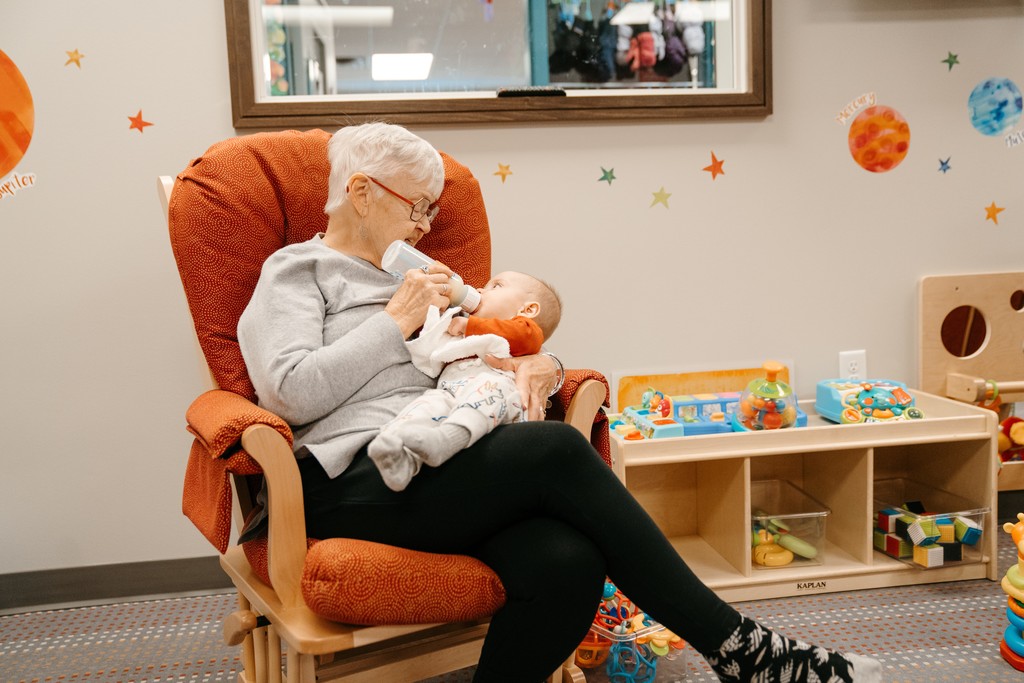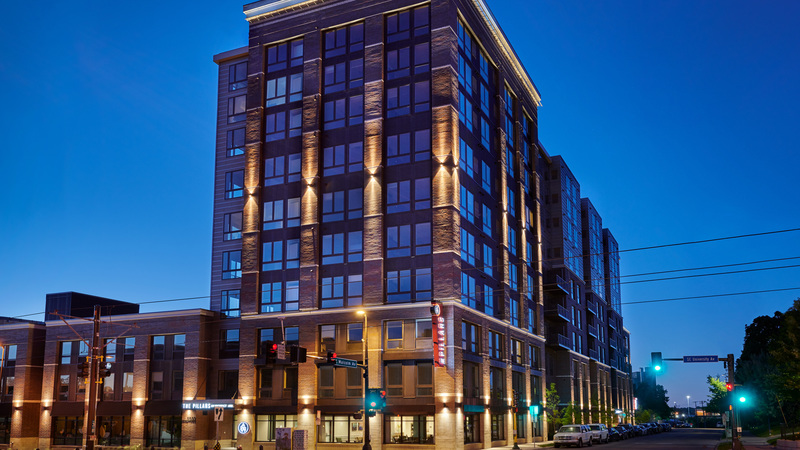Senior housing caters to kids and college students, building intergenerational community
Senior housing caters to kids and college students, building intergenerational community
More developers are embracing the idea of giving older adults opportunities to interact with those outside of their age range.
Sharon Toogood Froehle is in her 80s, lives in a senior community and doesn't have great-grandchildren of her own, yet she still has plenty of young people around her, whether that kid-fix comes in the form of rocking a baby, playing with a toddler or going on a walk with a teenager.
She and her wife, Marsha, moved from rural Minnesota into Minneapolis' Pillars of Prospect Park a year ago. But the senior apartment building isn't just for older adults. There are 15 studios for college students who receive discounted rent in exchange for spending a dozen or so hours every month interacting with older residents. There's also an on-site day care on the ground floor that emphasizes activities for the seniors and kids to do together.
"We watch the little ones come in the early morning and leave in the afternoon," she said, referring to the more than 100 toddlers, or "grandfriends," as residents call them. "That's the thing that sold us on this place."
A growing number of developers are catering to an unexpected demographic when it comes to residencies for older adults: kids. They're building age-restricted senior communities with a range of features and amenities aimed at creating "intergenerational" interaction.
"Seniors don't just want to sit around and play bingo anymore," said Jamie Korzan, vice resident of investor relations for Twin Cities-based Oppidan, a national developer that's at the forefront of the the trend. The concept is something of a turnabout for the industry, which just decades ago offered few options beyond nursing homes. Today, seniors have never had more choices for how to spend their retirement years, in part because the population has never been older.
There were about 76 million baby boomers born from 1946-64, the largest generation by births and still the second-largest behind millennials. By 2030, all baby boomers will be age 65 or older, and the developers who build for them are reforming their once-held belief that seniors live best alongside only other seniors. Now it's an all-ages approach to aging-in-place.
A desire for community
Michelle Pribyland her team have been working on a project in Duluth called Brae View, which nonprofit One Roof Community Housing and Essential Health are developing. The project, which is not yet under construction, will include 72 senior apartments as well as a day care with a play area, community room, patio, garden and other activity spaces.
"I laugh at how many times I hear [older] people say, 'I don't want to just live with a bunch of old people,'" said Pribyl, housing studio lead at LHB Architects in Minneapolis. "Seniors are very active, and they're not just looking for just a quiet place to be by themselves."
Pribyl said traditionally, many senior communities were often "islands" with limited access to other people and places, making it difficult for residents to feel connected to the world around them. The harmful effects of such isolation, she said, became even more obvious during the COVID-19 pandemic when most senior communities were on full lockdown.
Donna Butts, executive director of Washington, D.C.-based Generations United, said the intergenerational model isn't new, but it's quickly gaining traction with a new generation of younger retirees. That audience is ready to downsize but doesn't necessarily want to hide away in sprawling seniors-only communities where the focus is on what Butts calls the three Ps: pain, pills and passing.
"As people are living longer, they want to live with people of other generations," she said. Pribyl said financing such projects is challenging, especially if they target lower-income residents, because such mixed-use projects often require multiple forms of unconventional funding.
"It takes a special team," Pribyl said. "But from a design perspective, it's fascinating to think about how multiple uses co-exist within a building, especially when you're trying to create opportunities for interaction."
Senior communities with resort-style amenities can also take deep pockets. At Pillars of Prospect Park, a first-floor one-bedroom apartment with 691 square feet is now available for a base price of $3,370 a month, not including assisted-living services and other up-charges. Income-restricted projects developed with tax credits, public subsidies and targeted low-interest loans for low-income seniors and those with no assets can cost significantly less.
United Properties, the largest commercial developer in the state, is tailoring many of its senior communities to downsizing baby boomers who are ready to swap the home where they raised their family for a more maintenance-free existence.
"There's a younger generation of seniors who want to live a carefree lifestyle," said Naomi Ohnstad, development director for United Properties, "but want to live in a community setting that's inclusive."
In late 2021, the company said it was going to triple the number of senior living communities it owns and develops in the next three years under its Amira brand, which includes three living options for seniors.
Amira's independent living rental buildings are restricted to people 55 and older but sport many amenities for kids. That includes art rooms with crayons and paints and sports facilities, including swimming pools and simulators.
Ohnstad said kid-friendly amenities vary by location. At Amira in Bloomington, for example, there's a kids space next to a club room where kids can play video games and sit down with a coloring book.
The company is selecting sites in the suburbs with a high concentration of single-family houses and an aging population because the company recognizes boomers don't want to leave their community or relocate so they can be closer to their grandchildren.
Developers are also creating master-planned communities that mix different kinds of housing. In south Minneapolis, Lupe Development Partners and Wall Cos. are developing Snelling Yards, which includes both senior and affordable family rental housing where a playground and green space will connect several generations.
"Active living is a new segment. Nursing homes are the third rail of senior living. People don't want to be boxed into that," said Steve Minn of Lupe Development. "It's the new model."
Like many developers, Lupe and Wall partner with organizations that specialize in managing senior communities. At Snelling Yards, Ecumen is managing the now fully leased Hillock, an independent senior building where residents can't earn more than $46,320 annually, but the monthly rent for a one-bedroom apartments is under $1,000.
At Oppidan, which has already developed nine Pillars Senior Living Communities in Minnesota and three in California, Twin Cities-based Ebenezer Management Services is the on-site manager.
"There's something to be said for what generations can give to one another if they have time and space to be together," said Ann Schrempp, Ebenezer's corporate director of lifelong learning.
Experience to share
At Pillars, which has 283 apartments with independent living, assisted living and memory-care options, the Student Residence Housing Program has been so successful, they've expanded from 10 to 15 college students.
Shahraz Qamar, a medical student at the University of Minnesota who had been living with his dad in Rochester, moved into a studio apartment in the building almost a year ago. In exchange for the time he spends with the seniors, he pays a slightly reduced rent. The interaction with seniors is an opportunity he relishes because his nearest grandparent lives in Austin, Texas. Plus, those interactions are compatible with his interest in neurology.
"These people have lived their whole lives and have so much to tell," he said. "Whether
it's about politics or philosophy or life experiences."

Media Inquires Contact: [email protected]

